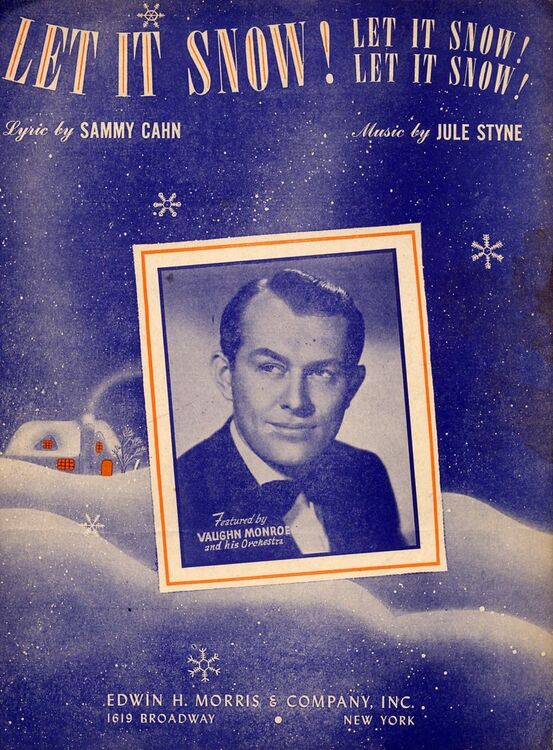 | Let It Snow! Let It Snow! Let It Snow!Vaughn Monroe |
Writer(s): Jule Styne (music), Sammy Cahn (words) (see lyrics here) First Charted: December 22, 1945 Peak: 15 BB, 15 BS, 15 DJ, 15 JB, 2 GA, 16 SM, 12 HP, 2 DF (Click for codes to charts.) Sales (in millions): -- Airplay/Streaming (in millions): -- radio, 1.34 video, 2.06 streaming |
Awards:Click on award for more details. |
About the Song:Lyricist Sammy Cahn and composer Jule Styne wrote “Let It Snow! Let It Snow! Let It Snow!” in July 1945 during a heat wave in Hollywood, California. WK Cahn would go on to write four Academy Award winning songs. “Three Coins in the Fountain” (1954), “All the Way” (1957), and “High Hopes” (1959) were all popularized by Frank Sinatra. Styne also worked on “Three Coins” and he and Cahn also teamed up for Academy Award nominees “I”ve Heard That Song Before” (1942), “I’ll Walk Alone” (1944), “Anywhere” (1945), “I Fall in Love Too Easily” (1945), “It’s Magic” (1948), and “It’s a Great Feeling” (1949). It has become a seasonal favorite “despite not mentioning Christmas in the lyrics, nor the holiday season.” SM Instead, it is “about being warm and cozy at home in wintertime,” SM cuddling up with someone, and popping corn. Billboard magazine ranked it the second biggest Christmas hit from 1935 to 1954. TY2 The song experienced a revival when it was included in the 1990 Bruce Willis’ movie Die Hard II. Vaughn Monroe was the first to record it that fall. It became a hit that Christmas, reaching #1 for 5 weeks. He was a “big-voiced baritone, trumpeter, and bandleader” PM who charted 67 times from 1940 to 1954. “Let It Snow! Let It Snow! Let It Snow!” was his sixth of nine #1 songs. PM Three other versions of the song charted in 1946 – Woody Herman (#7), Connee Boswell (#9), and Bob Crosby (#14). PM Frank Sinatra’s 1950 version of the song charted in Australia (#17), Canada (#28), and the UK (#33). Dean Martin recorded the song in 1959 although it would be 2018 before it reached the Billboard Hot 100, going all the way to #8. Others who have charted with the song include George Strait (#72 CW, 1999), Michael Bublé (#1 AC, #44 UK, 2003), Jessica Simpson (#20 AC, 2004), Carly Simon (#6 AC, 2005), Mannheim Steamroller (#26 AC, 2007), Toby Keith (#53 CW, 2007), Rod Stewart & Dave Koz (#1 AC, 2012), Dave Koz with Kenny G (#14 AC, 2014), Seal (#11 AC, 2017), and Pentatonix (#17 AC, 2017). Resources:
Related Links:First posted 12/20/2023. |








